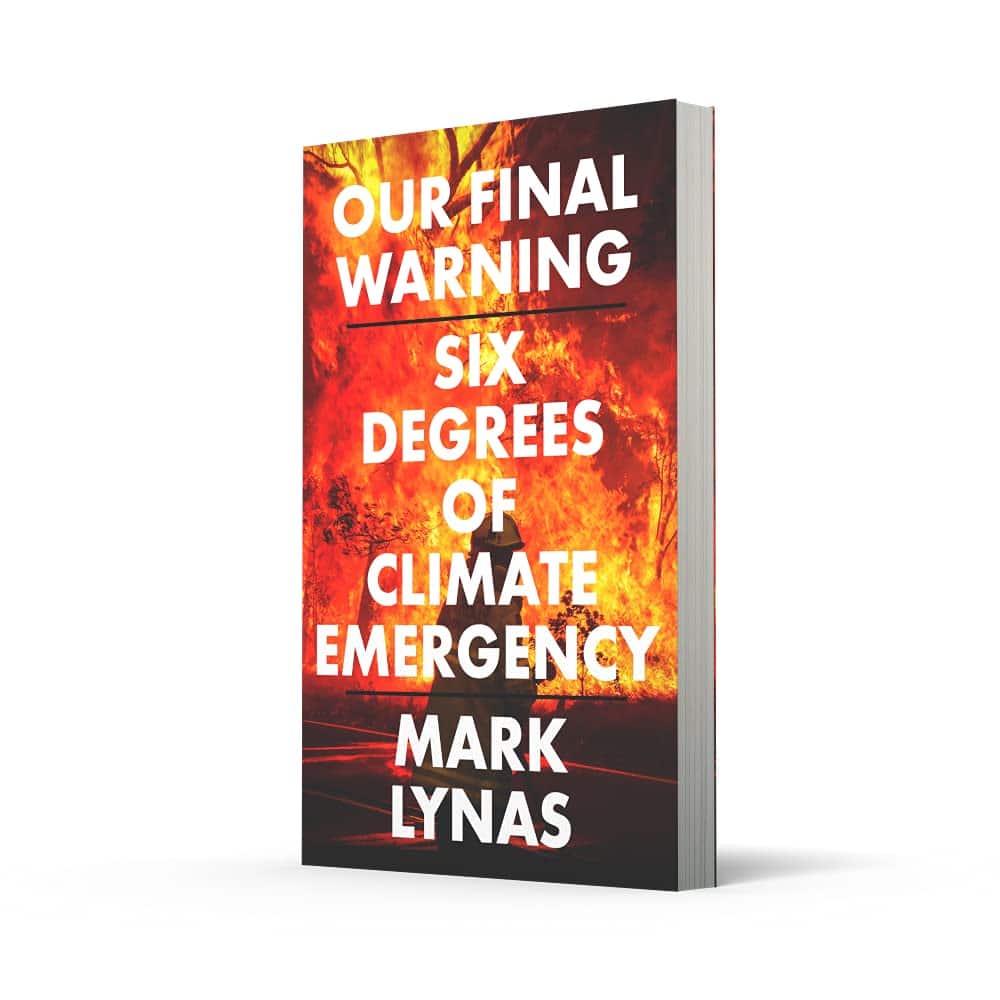Collapsing ice sheets, torrential dust clouds and deadly heat waves. What will the future hold for us if atmospheric carbon levels continue to rise, industries continue to pollute and governments fail to enact firm changes? From the 1 degree world we currently live in up to the hellish land the Earth would be under 6 degrees of warming, journalist Mark Lynas shows in his latest book Our Final Warning: Six Degrees of Climate Emergency exactly what this future would look like. The science is in, and if this truly is our final warning, it is well past time to take notice.
—
In 2007, Mark Lynas published the original Six Degrees, a breakdown of what changes to the Earth’s climate and geophysical characteristics we can expect for each degree of warming, from 1 to 6 degrees. Six Degrees was innovative in how it framed the crisis. Each chapter in the book addressed another degree of warming, and included detailed descriptions of how that much atmospheric carbon would impact climate, oceans, temperatures, glaciers and all life on Earth. Six Degrees expertly escalated the dread, despair and nightmarish conditions of an increasingly warm world.
The book certainly had a massive impact. A decade and a half on, it continues to be relevant and cited around the world. In what can be considered an IPCC report for non-scientists, Six Degrees was a highly functional tool for the general public to understand why global temperature rise is such a terrifying thing.
The popularity of Six Degrees was part of the reason why Lynas felt the need to once more undergo the surely laborious process of reading hundreds of academic studies on projected climate change impacts and compiling them into a tidily organised book. 2020’s Our Final Warning is a timely update on the original, full of updated information and new proposed solutions.
You Might Also Like Earth.Org’s review of Under a White Sky, by Elizabeth Kolbert.
To be clear, climate science hasn’t radically changed since 2007. “Arguably, the science has been established since the late 19th century,” Mark told Earth.Org in an interview. We are more granular about what we now know, our modelling systems are better and our projections hopefully more accurate. But if the science hasn’t really changed that much, then why update the book at all?
“It was probably because of Trump, to be honest,” Mark said with a laugh, when asked if anything in the world over the past ten years had fueled more pessimism in him than when he wrote Six Degrees. Politics and the rise of far-right political leaders resistant to affirmative climate action have certainly created more frustrating roadblocks than anyone ever predicted would exist this late in the game, making the climate crisis much more urgent than it should have been. “The extent to which I felt pessimism was really a reflection of the international political system more than anything else,” as Mark explained.
For someone not well-versed in what the future of relentless climate change really means for the world, Our Final Warning holds immense value. Lynas pored over studies, models and projections so that we don’t have to, and wrote about it in an effective and accessible style. The book does not give into dramatics, and refrains from excessive speculation. If current climate science has not expressed sufficient certainty over a possible outcome, it is not in this book.
Lynas’ book is about the ‘known knowns,’ rather than the unknowable possible futures of climate change that can inspire somewhat sensationalist emotions. It is why the 6 degrees chapter is approximately half the length of the 2 degrees chapter. Lynas acknowledges that, if we are unfortunate enough to hit those five or six degree markers, the world will be so cataclysmically different that modern science can scarcely imagine it. Such a future is thankfully unrealistic now, as the world’s leaders finally begin to acknowledge the urgency of the situation, but as of 2021, we are still probably on track for warming to hit somewhere between 2 and 3 degrees of temperature rise.
This will still be disastrous, and modern science is able to tell us with impressive accuracy just how bad it could get. Lynas does an excellent job summarising what these futures will look like if we do not get our act together soon.
But Our Final Warning, despite being written during a more pessimistic and annoyingly slow era of climate action, is far from being nihilistic. It spreads itself over six terrifying degrees of mounting terror, but peppered in throughout the book are enough nuggets of hope and belief in humanity that maybe, just maybe, we can figure a way out of this mess.
Reading a book detailing the disastrous scientific effects of climate change could easily be a drab and depressing experience, but this is not that kind of book. Anyone who reads through Our Final Warning and feels hopeless is misinterpreting its message. We will always have more work to do. As Lynas points out, 1.5 degrees of temperature rise is better than 2, which is better than 2.5 and which is itself better than 3 degrees. We can never stop, because every second we spend rebelling against a dark future has the potential to make it just a little bit brighter.
This book is a call to action, whatever that action might mean to you. Maybe it’s voting for environmentally progressive political candidates, or supporting organizations dedicated to tackling and addressing climate change. Whatever it is, any call to action needs a common goal. Our Final Warning paints a picture of a catastrophic future we need to rebel against. If we do that collectively, then hopefully nothing described in this book will ever come to pass.
Our Final Warning: Six Degrees of Climate Emergency
Mark Lynas
2020, 4th Estate, 372pp














